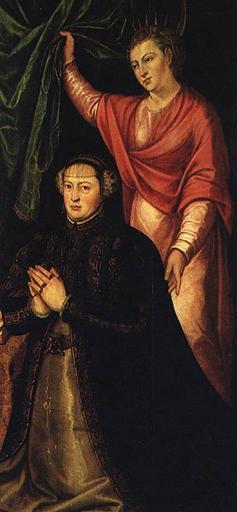MAKE A MEME
View Large Image

| View Original: | Catherine,_Queen_of_Portugal,_niece_of_Catherine_of_Aragon.jpg (400x865) | |||
| Download: | Original | Medium | Small | Thumb |
| Courtesy of: | www.flickr.com | More Like This | ||
| Keywords: catherine of aragon catherineofaragon european royalty europeanroyalty portrait Catherine of Austria, also called Catherine of Castile or Catherine of Burgundy (14 January, 1507 – 12 February, 1578) was (as wife of King John III of Portugal) Queen consort of Portugal from the House of Habsburg. On 10 February, 1525, Catherine married her first cousin John III of Portugal. They had nine children, but only two survived early childhood. Altarpiece by Cristóvão Lopes in the Convent of Madre de Deus in Lisbon depicting Catherine of Austria with her namesake, St. Catherine of Alexandria. Currently on display in the National Museum of Ancient Art in Lisbon. An Infanta of Castile, Archduchess of Austria and Princess of Burgundy, she was the posthumous daughter of Philip of Habsburg by Joanna of Castile. She was named in honor of her maternal aunt, Catherine of Aragon, first wife of Henry VIII, King of England. She remained with her disturbed mother until the arrival in Spain of her eldest siblings (Eleanor and Charles), all her elder siblings (bar her brother Ferdinand, who had also been born in Spain, and raised by their grandfather) had been put into the care of Margaret of Austria, but Joanna kept hold of her young daughter Catherine; Catherine was kept with her mother in her prison cell during her grandfather's time as regent. Nobody would dare take Catherine off her mad mother so Catherine stayed with Joanna, Catherine had nothing to do all day, her only entertainment was to look out of the window, two ladies in waiting would keep the mother and daughter company. Eleanor brought about the creation of her own household within the castle their mother was virtually imprisoned in. She was a younger sister of Eleanor of Habsburg, Charles V, Holy Roman Emperor, Isabella of Habsburg, Ferdinand I, Holy Roman Emperor and Mary of Habsburg. After the death of her husband, she was challenged by her daughter-in-law (her niece, Juana) over the role of regent for the infant King Sebastian. Mediation by Charles V resolved the issue in favour of his sister Catherine, over his daughter Juana, who was needed in Spain in the absence of Phillip II. Catherine of Austria, also called Catherine of Castile or Catherine of Burgundy (14 January, 1507 – 12 February, 1578) was (as wife of King John III of Portugal) Queen consort of Portugal from the House of Habsburg. On 10 February, 1525, Catherine married her first cousin John III of Portugal. They had nine children, but only two survived early childhood. Altarpiece by Cristóvão Lopes in the Convent of Madre de Deus in Lisbon depicting Catherine of Austria with her namesake, St. Catherine of Alexandria. Currently on display in the National Museum of Ancient Art in Lisbon. An Infanta of Castile, Archduchess of Austria and Princess of Burgundy, she was the posthumous daughter of Philip of Habsburg by Joanna of Castile. She was named in honor of her maternal aunt, Catherine of Aragon, first wife of Henry VIII, King of England. She remained with her disturbed mother until the arrival in Spain of her eldest siblings (Eleanor and Charles), all her elder siblings (bar her brother Ferdinand, who had also been born in Spain, and raised by their grandfather) had been put into the care of Margaret of Austria, but Joanna kept hold of her young daughter Catherine; Catherine was kept with her mother in her prison cell during her grandfather's time as regent. Nobody would dare take Catherine off her mad mother so Catherine stayed with Joanna, Catherine had nothing to do all day, her only entertainment was to look out of the window, two ladies in waiting would keep the mother and daughter company. Eleanor brought about the creation of her own household within the castle their mother was virtually imprisoned in. She was a younger sister of Eleanor of Habsburg, Charles V, Holy Roman Emperor, Isabella of Habsburg, Ferdinand I, Holy Roman Emperor and Mary of Habsburg. After the death of her husband, she was challenged by her daughter-in-law (her niece, Juana) over the role of regent for the infant King Sebastian. Mediation by Charles V resolved the issue in favour of his sister Catherine, over his daughter Juana, who was needed in Spain in the absence of Phillip II. | ||||